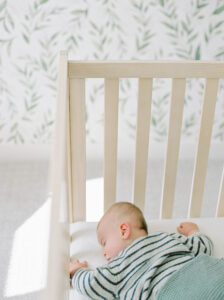Having a nap and bedtime schedule can be a total game-changer — not just for your baby’s sleep, but for your sanity, too. But between wake windows, clock-based schedules, sleepy cues, and all the TikTok sleep hacks floating around, it’s easy to feel like you need a PhD just to figure out when to put your baby down for a nap.
Let’s break it down in a way that actually makes sense and works in real life.
What are wake windows?
Wake windows refer to how long your child is awake between two sleep periods. This could be from when they wake up in the morning to their first nap, between naps, or from their last nap to bedtime. The idea is that each age group has a certain amount of stamina before they need sleep again, and the goal is to get your child down before they get overtired.
For newborns, wake windows begin from the moment their eyes pop open. For older babies and toddlers, wake windows begin when they’re up and out of the crib.
Too much awake time = overtired, cranky, harder to fall and stay asleep.
Too little awake time = not tired enough, short naps, and frustration all around.
Wake windows can absolutely be helpful, especially in the early months. But the goal is to turn those windows into a predictable daily rhythm — aka a clock-based schedule — that can bring structure and predictability to everyone’s day and make sleep easier for your little one too.
Wake windows vs. clock schedules
You’re the parent and you get to decide the schedule strategy that works best for your family, but I’m a big fan of clock-based schedules. As a busy mom juggling 84 things before breakfast, having consistent nap and bedtime times (vs constantly recalculating each day based on wake windows) can give you so much more predictability and freedom in your day. No more doing mental math every time your baby yawns!
That said, getting to a point where a clock schedule actually works often starts with understanding wake windows. Especially in those early months when sleep feels chaotic and unpredictable, wake windows give you just enough structure to start spotting patterns and making sure your baby’s awake long enough—but not too long—so they’re set up for better, more restful sleep.
As your baby matures and starts consolidating their naps and sleeping more independently, you’ll probably notice their sleep starts to fall into a more predictable pattern. That’s your sign to lean more into the clock instead of the calculator.
And if you’re already a schedule person and want to skip the guesswork, my Nap Guide has every nap schedule you’ll need from now until your baby ages out of napping!
But what if my baby is showing sleepy cues?
Sleep cues (yawning, rubbing eyes, pulling ears, zoning out) are worth paying attention to… kind of. Sleep cues can be very misleading, and only relying on them to dictate your next nap can backfire.
Some babies show what look like sleepy signs way too early, especially if they’re bored, overstimulated, or just kind of over it. If you rush to put them down, they may take a short nap simply because they weren’t actually tired enough yet. On the flip side, some babies really know how to rally and blow right past their optimal nap time without so much as a yawn, which can leave you scrambling to get them down after they’re already overtired and melting down.
If your little one is showing sleep cues about 5-10 minutes before their expected nap time? Perfect — their body is right on schedule! But if they’re suddenly acting sleepy 30-60+ minutes before their nap is “due”, try a change of scenery, a snack, or some fresh air first. You might just buy yourself a longer, better nap later.
We have a great schedule but sleep still feels hard
Schedules are only one piece of the sleep puzzle. If your baby still needs help falling asleep, wakes up frequently, or takes consistently short naps, it may be less about timing and more about how they’re falling asleep.
But don’t worry – sleep is a skill and something they can totally learn with the right support.
Whether you’re ready for a step-by-step custom sleep plan or want to check out my sleep course, I’m here to help you make sense of the whole sleep picture, not just hand you a nap chart and a prayer.
TLDR: Don’t let wake windows rule your life!
I love wake windows as a helpful starting point — especially for babies under 4 months — but they’re not meant to dictate your every move. If you’re stuck tracking every minute of awake time and still feeling like your day is all over the place, that’s a sign it’s time to transition into a more predictable, clock-based rhythm.
You don’t have to choose between structure and flexibility. The goal is to get sleep working for you, not the other way around.
And if you’re ready for that kind of consistency, I’m here to help!














